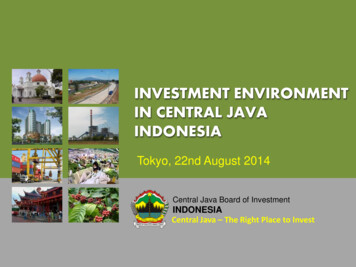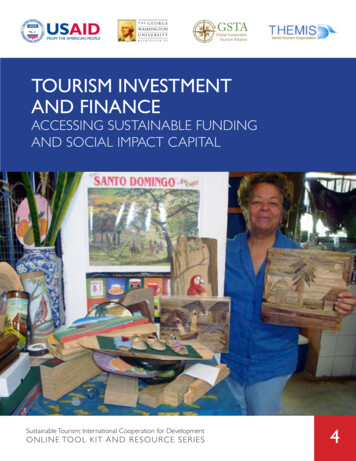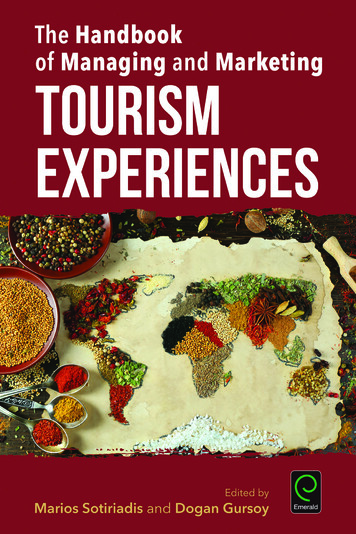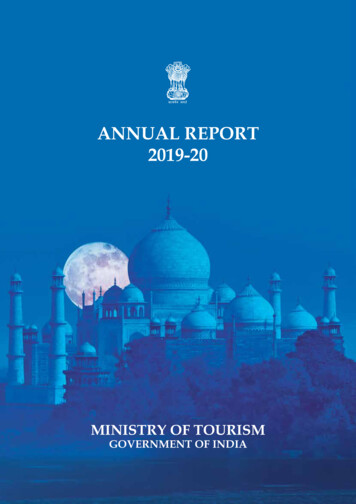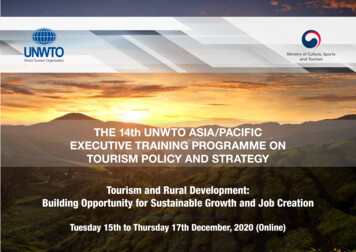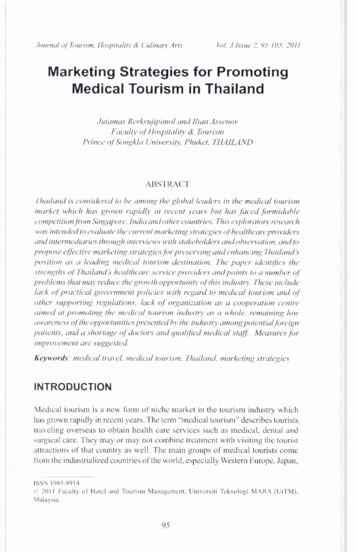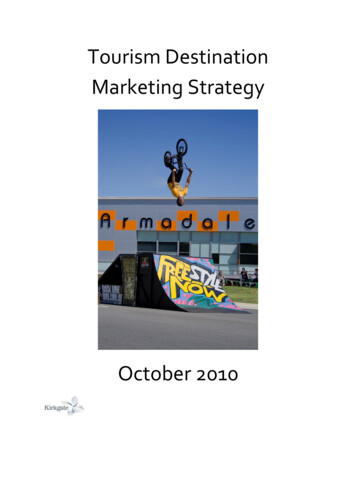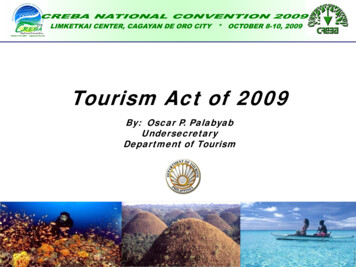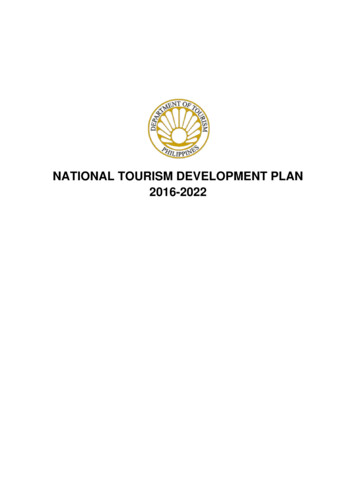
Transcription
NATIONAL TOURISM DEVELOPMENT PLAN2016-2022
Map of Cluster Destinations1
IntroductionThe National Tourism Development Plan 2016-2022 is a continuation of the NationalTourism Development Plan 2011-2016 formulated in 2010 by the Department ofTourism as mandated by Republic Act 9593 or the Tourism Act of 2009. It wascompleted with the assistance of Asia Pacific Projects, Incorporated, in associationwith Indra Philippines.The vision of developing a highly competitive and environmentally sustainable tourismindustry that is focused on creating inclusive growth was adopted to provide the longterm implementation framework consistent with the declaration of policy set forth inthe Tourism Act of 2009.The Department of Tourism started the review of the original Plan in December 2015followed by extensive consultations with National Government Agencies and privatetourism-related associations in January 2016. Through March 2016, a series of focusgroup discussions and consultations were undertaken on a regional, provincial, andlocal level participated in by sectors representing local tourism and business councils,local government units, non-governmental organizations, and the academe.The extensive discussions were also supported by a SWOT survey conducted amongthe participants which essentially validated some issues identified in the first Plan ascontinuing challenges that remain to be addressed in the coming years. The industry’sperformance vis-à-vis the economic goals and targets set forth during the period of2011-2016, likewise, formed the basis for strategic programs and action planscovering 2016-2022 laying down the basis for the new goals and targets.Efforts have been undertaken to consolidate the gains already made and adopt a morestrategic and innovative approach in exploring new opportunities to pursue inclusivegrowth which will be done by expanding community participation across the full rangeof facilities and services planned in the tourism circuits and development areas.Continuity is the cornerstone of the new Plan with special focus on what is achievableas well as on building on the momentum of what has already been initiated throughthe efforts of the numerous stakeholders comprising the tourism industry.National Tourism Development Plan 2016-20221
The NTDP 2016-2022 seeks to build and upscale the implementation of tourismprograms through a focused and prioritized approach which is designed to deliver amore competitive, sustainable and inclusive tourism sector.I.Philippine Tourism Industry ProfileTourism Act of 2009: Republic Act 9593, otherwise known as the Tourism Act of2009, provides for the improvement of the Philippines’ tourism competitiveness.Outlined in Section 36 is the need for updated national tourism plans to address theevolving needs and capabilities of the industry.Economic Performance: The growth of foreign visitors and domestic travelers duringthe period of 2011-2015 together with the attendant increases in their lengths of stayand daily expenditures resulted in an increase in internal tourism expenditures to Php2.0 trillion in 2015 up from 1.4 trillion in 2011. Likewise, tourism gross value added ofPhp 1.0 trillion represented an 8.2% increase share of the country’s GDP. Employmentin the tourism sector also grew to 5.0 million reflecting a 12.7% increase of nationalemployment over the previous year (2014).6,000,000Others5,000,000Australia & New Zealand4,000,000ASEAN3,000,000Europe2,000,000North America1,000,000East Asia02010 2011 2012 2013 2014 2015Philippine International Arrivals by Region (2010-2015)2Foreign Markets: The East Asian region representing the countries of Korea, Japan,and China comprises the largest source markets for the Philippines, constituting49.2% of total international visitor traffic in 2015, and will continue to be the leadingsource markets in both the short and medium term periods as air seat capacities aresufficient to accommodate larger traffic volumes.North America, consisting of the United States of America (USA) and Canada, withover 938,000 visitor arrivals in 2015, constitutes the 2 nd largest regional source, at17.5% of the total visitor traffic to the country. This market, being mainly FilipinoAmericans, contribute substantially to foreign exchange receipts due to their extendedlength of stay averaging 12.4 days. North America also represents a main source ofrepeat visitors.2National Tourism Development Plan 2016-2022
Europe is the 3rd largest regional market source with the United Kingdom, Germany,and France as the main source countries, with the Scandinavian sub-region likewiseexhibiting positive growth rates during the past years. The continued absence of directflights from European air carriers (Philippine Airlines operates London-Manila-London5 flights weekly) has dampened marketing efforts, though the Philippines continues tobe featured as part of multi-country itineraries for adventure travelers. Twinningprograms with ASEAN air carriers, particularly Singapore Airlines, should be exploredto increase market share coming from identified European markets.ASEAN is the 4th largest regional source market, comprising 9.0% of the totalinternational traffic with the countries of Singapore and Malaysia as the top markets,considering their extensive air services to the country. Further growth can be achievedby pursuing intensive promotional activities in Indonesia, Thailand, and Vietnam bypushing new products (Entertainment City in Manila, and cultural and historicaldestinations in the Visayas Region).Australia and New Zealand are the 5th largest source markets, exhibiting a respectablegrowth rate of 8.0%, reflecting the increase in air routes to Australia, and is bound tofurther grow due to the possible introduction of direct air services by New Zealand’snational air carrier. While relatively small in volume (261,000 in 2015), the duration ofstay by these travelers average more than 10 days.All country markets posted positive growth rates in 2015 with double-digit growth fromChina, Taiwan, Korea, United Kingdom, and Malaysia. The overall total of 5,360,682for 2015 represented a 10.91% growth rate over 2014, reflecting a sentiment that theindustry has now recovered over the natural calamities that befell the country in thepast three years. Political issues with some neighboring countries, likewise, have beenquietly resolved, if not set aside, and a “business as usual” attitude has prevailed.Of particular significance are the short haul markets of Hong Kong and Taiwan thathave gradually stabilized and are expected to improve its growth rate in the comingyears. Improvements of the Philippine image as a safe and secure destination isimportant as both Hong Kong and Taiwan, though small in terms of their populationbase, are rich sources of continuous and repetitive visitors.The ASEAN region, through the establishment of a regional bloc, should be capitalizedon as unrestricted access for regional carriers have been ratified by member countries.As it is, only Singapore and Malaysia appear in the Philippines’ top country markets.Arrivals, therefore, could pickup with more air routes being introduced andimprovements on our product offerings for this regional market being initiated.Domestic Market: The volume of domestic travelers rose to 67.81 million per datafrom the 2015 Domestic Household Survey conducted by the Philippine StatisticalAuthority. This rise in domestic travelers represents a CAGR of 14.3% for the period2010 – 2015, reflecting the increasing economic growth rate per capita (GrossDomestic Product grew at an annual rate of 5%, and Gross National Income at 4.2%National Tourism Development Plan 2016-20223
higher than the 2.04% population growth rate). Likewise, the growing acceptance oftravel as part of the modern lifestyle and to a certain extent, the increasing urbanizationof society, resulted in the need to seek different environments and activities away fromcities. The volume of domestic travelers include “excursionists” or persons who traveloutside their usual place of residence and return on the same day as differentiatedfrom a tourist who would stay at least 24 hours away from his residence.The average daily expenditure of the domestic traveler grew from Php 1,686/day toPhp 2,172/day from 2010 to 2015 while their length of stay was assumed to be aconstant of 5 nights.The same study calculated a total revenue of Php 1,771 billion in 2015 whichaccounted for 18% of a Filipino household’s final consumption.Purpose of Visit: The dominant reason for visiting the country has been traditionallyfor leisure and holiday purposes (56.37%) and considering the popularity of island andcoastal destinations, could very well be mainly for beach holidays and other naturebased activities. The second main purpose is for visiting friends and relatives at 8.80%,closely followed by the third group segment that identified business as their mainpurpose of travel (7.59%%).Other reasons cited for travelling to the Philippines consisted of education purposes,attendance to conventions and incentive meetings, official missions, and medicalreasons, among others.Length of Stay: The average length of stay of international visitors to the country grewfrom 8.0 nights in 2010 to 9.9 nights by 2015. These figures are one of the longest inASEAN. They are led by visitors emanating from the USA at 12.4 nights while Koreanvisitors stayed for a period of 5.4 nights for the year 2015.Daily Expenditure: The average daily expenditure by foreign tourists in 2015 stoodat US 107.4/day, showing an improvement over 2010 by US 23.5. Accommodationexpenses topped the expense category at 36% which showed a substantial increaseover 2010 figures by 13%, followed by F&B related expenses, at 26% of their averagedaily expenditure. Shopping expenditures stood at 16%, down from the high of 27%posted in 2010.Following are entertainment at 14%, and transport expenses, which stood at 5% offoreign visitors’ average daily expenditure.4National Tourism Development Plan 2016-2022
Tourism Products: The 2011-2016 NTDP called for the implementation of a tourismproduct strategy through the enhancement of existing products and the introduction ofnew ones as a manner of diversifying the country’s product portfolio to increase thelevel of competitiveness and improve the travel experience of visitors.A bottom-up approach shall be adhered to in the formulation of local tourism plans.The extent of tourism site development embodied in the 49 Tourism DevelopmentArea Profiles particularly those catering to nature- and culture-based tourism will bethe decision of Local Government Units and community stakeholders in adherence tosustainability and inclusive growth objectives. Nature/Adventure type of products areseen to be a growing offering in the future, particularly those emphasizing eco-friendlypractices.The 2016-2022 NTDP continues to adopt the product portfolio originally developedand has identified the core products appropriate to the clusters and TourismDevelopment Areas. The tourism products have been categorized into:Cultural TourismNature t)Health, Wellness,and RetirementTourismSun and BeachTourismLeisure andEntertainmentTourismCruise & NauticalTourismDiving andMarine SportsTourismMICETourismEducationTourismPhilippine Tourism Product Portfolio3National Tourism Development Plan 2016-20225
The Figure below graphically measures the rank of the nine (9) products using theImportance criteria and the Ease of Implementation criteria:Measures of the 9 Product PortfolioThe Key Products consisting of Sun and Beach Tourism, Nature-Based Tourism,Cultural Tourism, as well as Diving and Marine Sports, should be given the highestpriority due to their strong attractiveness to a wide range of country markets. Effortsmust be undertaken to attract investments on the development of integrated beachresort destinations. Likewise, the need for developing sites and programs takingadvantage of the country’s rich cultural heritage and festivals should be pursued. Theopening up of selected National Parks for leisure pursuits, as well as ecotourism sites,will widen the scope of Nature-based Tourism offerings. Both nature and culture-basedproducts exhibit the highest potential for community participation, particularly in therural areas.The MICE, Shopping, Leisure and Entertainment as Strategic Products havedeveloped substantially these past years due to expanded infrastructure, particularlyin Metro Manila and in selected urban centers. These products are well situated toattract regional events and travelers but will continue to require investments andhuman resource development.Infrastructure issues for Cruise Tourism, particularly in improving transit ports of call,are now being addressed but still exhibit limited potential until such time as a dedicatedcruise terminal in Manila is put in place.Health and Wellness, Medical and Retirement Tourism facilities continue to pose aconstraint in its attractiveness from a global standpoint. Presently, they are not rankedas Key Products due to the considerable investments required to cater to the market.6National Tourism Development Plan 2016-2022
Education Tourism continues to be a Niche Product as the country’s appeal in thisarea is limited to one or two markets only. The country’s educational system has yetto be realigned to international standards. Substantial infrastructure limitations will alsohave to be addressed.The sub-product of Nautical Tourism, while exhibiting a big potential due to thecountry’s archipelagic nature, is considered as a Niche Product as it will requireinvestments in skilled labor and specialized infrastructure, and will need strongcompliance with safety and marine regulations.Airport Terminal Capacity TERMINALCAPACITY(2015)(M)3044.521.20.7TOTAL PAXTRAFFIC (2015)A B C(M)36.60.97.84.11.72.4DOM PAX(2015)B(M)19.400.045.804.101.620.99INTL y: The chart above shows that airports have exceeded capacities alreadyand that expansion is imperative.The continued rise of domestic travelers will also exert pressure on the ability ofPhilippine airports to accommodate and service the additional volume of airpassengers. The expansion of the country’s road network to major travel destinationsas well as new roads leading to the opening of tourism sites, while putting additionalpressure for increases in infrastructure investments, shall also impact in creating alarger base of beneficiaries representing job opportunities and expansion of smallscale business enterprises in provincial areas.National Tourism Development Plan 2016-20227
Room Capacity (2015)5RegionNCRCARRegion IRegion IIRegion IIIRegion IV-ARegion IV-BRegion VRegion VIRegion VIIRegion VIIIRegion IXRegion XRegion XIRegion XIIRegion XIIITOTALAccommodation CapacityEnterprisesNumber of 6,088Total Employment in the Philippines and Employment in Tourism Industries (2013)6(In thousand persons)TOTAL EMPLOYMENT IN THE PHILIPPINESTOURISM CHARACTERISTIC INDUSTRIESAccommodation, Food & BeveragePassenger Transport (land, water & air)Travel Agents, Tour Operators & Tour GuidesRecreation, Entertainment & Cultural ServicesRetail Trade on Tourism-characteristic GoodsMiscellaneous (incl. Health & Wellness etc.)SHARE OF TOTAL %Employment in Tourism Sector: As a labor-intensive economic sector, employmentin tourism-related industries grew by about 1 million jobs during the period 2010-2013reaching 4.7 million which represents 12.4% of the total employment in the Philippinesin 2013. Job opportunities will continue to grow substantially due to foreseendevelopment in the tourism industry in the coming years.8National Tourism Development Plan 2016-2022
II.Guiding Principles & VisionAligned with the key pillars of Ambisyon Natin 2040, “Matatag, Maginhawa, atPanatag,” and the framework of the Philippine Development Plan 2017-2022, theNTDP 2016-2022 envisions to:Develop a globally competitive, environmentally sustainable and sociallyresponsible tourism industry that promotes inclusive growth throughemployment generation and equitable distribution of income therebycontributing to building a foundation for a high-trust society.Tourism Cluster ConceptCluster Concept: In the pursuit of the tourism vision, the National TourismDevelopment Plan continues to adopt the cluster approach as a destinationdevelopment strategy in the implementation of complementing programs involvingtransport networks, infrastructure projects, accommodation and recreational facilities,human resource development, and marketing plans, all directed to support thedevelopment of tourism destinations throughout the country. From a physicalperspective, clustering involves linking several Tourism Development Areas (TDAs)into a logical grouping of transport networks, natural and cultural tourism sites, as wellas urban service centers that provide facilities and amenities, all serviced by at leasta primary gateway.TDAs have the following key attributes: Good air, sea, and road interconnected systems resulting in ease of travellingto and within areas; Presence of key infrastructure to support power, water, sewage/ solid wastedisposal and telecommunication requirements of the community and expectedvisitors; Sufficient supply of a range of accommodation facilities; Restaurants, shopping, recreational and entertainment facilities; and Day and half-day tour/sightseeing programs and activities to natural andcultural sites.National Tourism Development Plan 2016-20229
Some of the TDAs could lack some support infrastructure to adequately meet therequirements of both the community and expected visitors. Such deficiencies like poorlast mile access, inadequate power, lack of health and safety facilities as well ascomfortable and pleasant activities will be addressed in this plan.The 2016-2022 Plan has rationalized the number of TDAs from 78 to 49 so as toprovide greater focus on the relationship of adjoining clusters in order to implementthe proposed development of tourism circuits.NTDP 2016-2022 Tourism Development Clusters and AreasGroupingNorthernPhilippinesCluster DestinationsNP-1: BatanesNP-2: IlocosRegionNP-3: CagayanNP-4: CARNP-5: CentralLuzonNP-6: Metro Manilaand EnvironsCentralPhilippinesNP-7: Laguna,Batangasand QuezonCP-1: BicolCP-2: MIMARO10Tourism Development AreasNP-1A: BatanesNP-2A: Ilocos NorteIlocos SurAbraNP-2B: La UnionPangasinanNP3-A: CagayanIsabelaNP3-B: QuirinoNueva VizcayaNP4-A: ApayaoKalingaNP4-B: BenguetIfugaoMountain ProvinceNP5-A: ZambalesBataanNP5-B: ClarkSubicTarlacPampangaNP5-C: BulacanNueva EcijaAuroraNP6-A: Metro Manilae.g. Quezon CityMakati CityManila CityNP6-B: RizalNP6-C: CaviteNP-7A: LagunaBatangasNP-7B: QuezonCP1-A: Camarines NorteCamarines SurCatanduanesCP1-B: AlbayMasbateSorsogonCP2-A: MarinduqueCP2-B: RomblonCP2-C: Oriental MindoroOccidental MindoroNational Tourism Development Plan 2016-2022
GroupingCluster DestinationsCP-3: PalawanCP-4: WesternVisayasCP-5: CentralVisayas andNegrosIslandCP-6: EasternVisayasSouthernPhilippinesSP-1: Surigao andDinagatIslandsSP-2: Agusan RiverBasinSP-3: Cagayan deOro CoastandHinterlandSP-4: ZamboangaPeninsulaSP-5: Davao GulfAnd CoastSP-6: Cotabato &SaranganiSP-7: ARMMTourism Development AreasCP3-A: Calamianes Group ofIslandsCP3-B: North Main LandCP3-C: South Main Land(Puerto Princesa)CP4-A: IloiloGuimarasCP4-B: AntiqueAklanCapizCP5-A: CebuCP5-B: Negros OrientalNegros OccidentalSiquijorCP5-C: BoholCP6-A: LeyteSouthern LeyteBiliranCP6-B: SamarNorthern SamarEastern SamarSP1-A: Dinagat IslandsSiargao IslandSP1-B: Surigao Del NorteSurigao Del SurSP2-A: Agusan del NorteAgusan del SurSP3-A: CamiguinSP3-B: Cagayan de Oro CityMisamis OrientalSP3-C: Misamis OccidentalIligan CityLanao del NorteSP3-D: BukidnonSP4-A: Zamboanga Del NorteSP4-B: Zamboanga Del SurSP4-C: Zamboanga SibugayZamboanga CityIsabela CitySP5-A: Davao Del NorteDavao CitySamal IslandSP5-B: Davao Del SurDavao OccidentalSP5-C: Compostela ValleyDavao OrientalSP6-A: CotabatoSP6-B: South CotabatoSP6-C: Sultan KudaratSP6-D: SaranganiSP7-A: BasilanTawi-TawiSuluSP7-B: Lanao Del SurMaguindanaoNational Tourism Development Plan 2016-202211
Convergence Concept: Following the recommendations for strengthening theinstitutional capacity of public and private stakeholders, ensuring participatorygovernance and creating successful partnerships, a tourism governance andmanagement framework was formulated to allow convergence of approach in national,regional, and local levels at both strategic and tactical horizons.Tourism Convergence PrincipleThe Convergence Principle draws heavily on Rule VIII-Tourism Governance andvarious chapters of the Tourism Act. Various sections spell out the sharedresponsibilities of the national and local governments particularly in tourismdevelopment planning, the formulation of an accreditation system as a basis forpromulgating rules and regulations in the operation of tourism enterprises, and thedesignation tourism zones and areas. The establishment of a tourism infrastructureprogram to support the needs for vital access roads, airports, seaports, and otherrequirements necessitated convergence programs with DPWH, DOTr, including DBMto provide priority status and funding of transport infrastructure programs. Likewise,together with DFA, DOJ, DTI-BOI and DOT policies and practices covering travelformalities and its facilitation are to be reviewed to develop systems and proceduresthat will encourage visits and longer stay of foreign tourists in the Philippines. Also, theNational Ecotourism Strategy formulated by DENR and DOT through the NationalEcotourism Steering Committee (NESC) integrated its efforts in identifying ecotourismsites for its development, conservation, and eventual conversion into TourismEnterprise Zones.12National Tourism Development Plan 2016-2022
Underdeveloped transport infrastructureand tourist facilitiesInconsistent standards in tourismfacilities and servicesPerceived concerns of personal safety oftravelersLack of political and economic stabilityLow awareness of the country's tourismproducts/destinationsInsufficient value for money offers intravel ry Concerns: Part of the Focus Group Discussions held in selected regionsinvolved the conduct of a SWOT survey that sought to identify and measure thegeneral characteristics and status of the tourism industry in both the national andregional contexts.Results from the survey showed that from both the national and regional perspective,the underdeveloped state of transport infrastructure and tourism facilities continue torank as the most urgent concern (the same result is resulted in the NTDP 2011-2016)and continue to be a weakness that requires immediate remedial action for stronggovernment investments and private sector involvement.A close second is the inconsistent standards in tourism facilities and services, followedby perceived concerns of personal safety of travelers. Such areas need to beaddressed in order to move the development of tourism forward.National Tourism Development Plan 2016-202213
Difficulty in mitigating the effects ofnatural disastersAggressive competition in tourism fromASEAN neighborsUncertain global economyContinuing existence of political unrest inthe Middle East and West phil Seas0National 20.511.52RegionalThreats8From a national perspective, natural disasters and aggressive competition fromASEAN neighbors are ranked as the top threats to Philippine tourism. The politicalunrest existing in the Middle East and certain parts of the west together withuncertainties in the global economy serve as the major threats to regional tourism.The Strategic Directions set forth in this Plan enumerates the various programsessential in addressing the weaknesses and threats which will require lobbying forsufficient resources to address infrastructure and security gaps. DOT and the privatesector should capitalize on the excess capacity to absorb travelers in the central partof the country through the expanded and new existing gateways in Cebu-Mactan,Iloilo, Bacolod, and eventually Panglao, Bohol while the proposed new internationalairport for Metro Manila is under study. New routes to tourist destinations serviced bythese gateways should be encouraged vigorously while at the same timeenhancement of tourist sites in destinations served by these gateways should beundertaken. Expansion of air charter operations should also be supported.14National Tourism Development Plan 2016-2022
III.NTDP Strategic Direction Action ProgramsNTDP 2016-2022 Strategic Directions and ProgramsIntensify Transport Infrastructure Development: Crucial to meeting the targets forboth foreign tourist arrivals and domestic air passengers is the successfulimplementation of capacity enhancement programs for the Ninoy Aquino InternationalAirport and all international gateways of the country together with the attendantmodernization of facilities and streamlining of operations. This includes meeting thecompletion schedules of the international airports in Bohol and Bicol (estimated 2020).The privatization of all international air terminal operations should also be studied byDOTr/CAAP. In support of the National Cruise Tourism Strategic Plan, designatedtransit ports of call have been identified for upgrading in order to accommodate cruiseships. The expansion of the Tourism Road Infrastructure Program with DPWH isrecommended to be pursued so as to develop tourism circuits and improveconnectivity with the designated tourism destination areas and tourism sites.National Tourism Development Plan 2016-202215
Distribution of International Visitors by Gateways (2015/20229)TotalInternational Share of Int’lDomestic ForeignProjected Int’l TouristPaxTouristTourists toTerminalPaxPaxTerminal ThroughputTrafficThroughputTotalCapacityTraffic 015)(2015)(2015)(2022)(2022)A (2015)Traffic (2015)BCFGB CDE D/CGatewayMillion nganTOTAL42.856.533.3521.5610.4548.5%60.73% 39.27%1680 Km1536 Km1400 Km900 Km35.0 Bn38.4 Bn42.0 Bn 1060 Km804 Km26.5 Bn22.5 Bn201720.1 Bn20182019202020212022Tourism Roads 2017-2022 (in Billions Php & Km)10Pursue Travel Facilitation Incentives: Aggressively promoting routes and additionalair services utilizing the new and expanded airports will be essential in providing thenecessary seat capacities to meet visitor targets. Likewise, crucial would be theadoption of a program to increase seat entitlements between the Philippines and thetargeted growth country markets through the conduct of air negotiations. Hand in handwith these initiatives would be introducing new immigration policies and procedures16National Tourism Development Plan 2016-2022
such as electronic visa issuances, visa-upon-arrival systems, and streamlining visaapplication systems, particularly for Indian and Chinese nationals.Attract Investment and Improve Business Environment: While transportinfrastructure development is being undertaken, equally crucial to the country’stourism competitiveness is expanding the available transportation equipment primarilythrough acquisition of additional aircraft, ferry vessels, and tour coaches (buses)together with the expansion of the country’s accommodation supply (i.e. hotel andresort rooms) through private investments in this sector. Expanding the tourist productofferings by fast-tracking TIEZA TEZ projects through the completion of plannedintegrated resort complexes, heritage and cultural theme parks, and ecotourismdestinations will provide the tourism industry a more diverse tourism experience. Withthe tourism incentives program of TIEZA resolved, an investment promotionscampaign highlighting the opportunities of developing tourism facilities in the county’sidentified tourism development areas, especially in the priority clusters, can now beundertaken.Expand Product Development Initiatives: The development of the tourism circuitsas proposed in this plan will result in greater connectivity between tourismdevelopment areas and sites which will, in turn, bring travel-related businessopportunities closer to local communities. Likewise, alternative travel through roadsand roll-on-roll-off port facilities will relieve existing pressure on airports. For theseproposed tourism circuits to thrive, improved access and visitor facilities to natural andheritage sites, monuments and landmarks, selected national protected areas andsanctuaries as well as service centers will have to be undertaken through public andprivate sector investments.Implement an Expanded Marketing Program: The coming years’ expandedmarketing program for foreign markets will consist of four major thrusts involving thecontinuation of the “It’s more fun in the Philippines” branding campaign, marketpenetration strategies through expanded trade and consumer activities in the 12 majormarkets, the design of market development programs for the identified 12 newmarkets, and product-market development programs specific to the tourism productportfolio, with emphasis on MICE and Cruising product
The 2016-2022 NTDP continues to adopt the product portfolio originally developed and has identified the core products appropriate to the clusters and Tourism Development Areas. The tourism products have been categorized into: Philippine Tourism Product Portfolio3 Cruise & Nautical Tourism Nature based Tourism-Nature Recreation &-Adventure:
